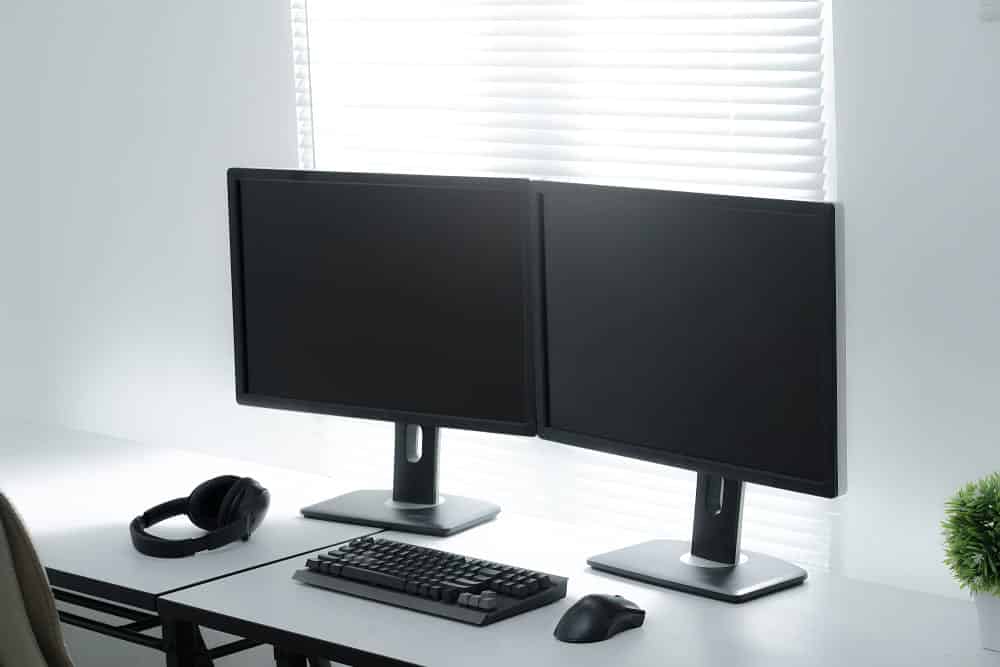
Setting up the dual monitors can increase work efficiency and productivity by multiple folds. That’s because you can open multiple internet tabs and open different apps at a time to edit everything.
For the most part, dual monitors are great for editing professionals, researchers, and gamers to increase productivity standards. It is totally possible, and you can make it happen with just a little bit of efforts.
How To Use Dual Monitors With Graphics Card And Onboard?
The firs thing that you will need to know is how you can achieve this, and here is how.
The GPU and I/O Panel
The first step is to check all the essential cable connections on the computer system, and they are generally located on the I/O panel. So, before you invest in the secondary screen, make sure to check this panel.
If the PC has a non-integrated GPU, you will find the GPU section with essential stocks. Then, you should check the types of display connections available. In case you have an advanced computer system, you should look for DisplayPort and HDMI.
In addition, some models have Thunderbolt 3 and USB-C ports. If you’ve to manage the old connection, you will need to use the DVI-I port. Some people tend to use a VGA port but it’s not suitable for connecting the second screen.
All in all, you must have two display ports for the monitor screen. Similarly, you have to consider which spare port can be used for attaching the new screen and the connection type. The users can connect the monitor as a second screen with the laptop (if there are compatible ports available).
Compatibility Of Monitors
When you have sufficient information about ports, you need to check the compatibility of monitor screens. Before you buy the monitor, you should check the ports and make sure they are the right type for connecting with the PC. Also, it’s best to opt for a thin bezel or non-bezel screen to ensure the dual monitor experience is streamlined.
Open The Display Settings
Once you’ve found the right monitor screens, switch on the main PC and choose display settings by right-clicking on the home screen. As a result, you will be able to see the connected display screen (yes, the secondary and primary displays). If the second screen doesn’t show up in the list, unplug and re-plug. Some monitors have a wireless option that can be used through the “connect to the wireless display” option.
Display Option
When both your monitors show up, you need to consider how they will work. On the top, you should select the secondary monitor and then open the display settings. Then, click on the multiple displays option and check out the available options. At this point, you have two options, such as;
- Extending desktop – both screens will work as one monitor and it will function as a single monitor
- Duplicating desktop – it’s suitable for training and teaching purposes where one screen is viewed by the
Check The Additional Display Settings & Adjust Accordingly
When you have opened the display settings, you can adjust different features to ensure both monitors are properly set up according to your needs. The users can change the resolution and orientation of both monitors.
For instance, if you are a videographer or a photographer, you can use a higher resolution on the 4K secondary monitor screen while other editing software options stay on the main screen. The resolution settings depend on the video output and GPU settings.
In addition to these settings, you can change the brightness level, adjust the scale, and switch on the night light mode to ensure seamless functionality in darker areas. It’s suggested that you set separate settings for both monitors and start experimenting.
When the setup is complete, we suggest that you browse tabs between different monitors or use the drag & drop feature. As a result, you will be able to start the PC and enjoy the dual monitor structure.
On the other hand, if you are having issues with the performance of the dual monitor, it’s best that you take a look at the GPU and related hardware limitations. Not to forget, some problems can be easily resolved by unplugging everything, checking the cables’ structural integrity, and re-plugging everything to optimize the monitor’s performance.
Last but not least, you can experiment with different GPU software and graphics card to experiment with the dual functionality.